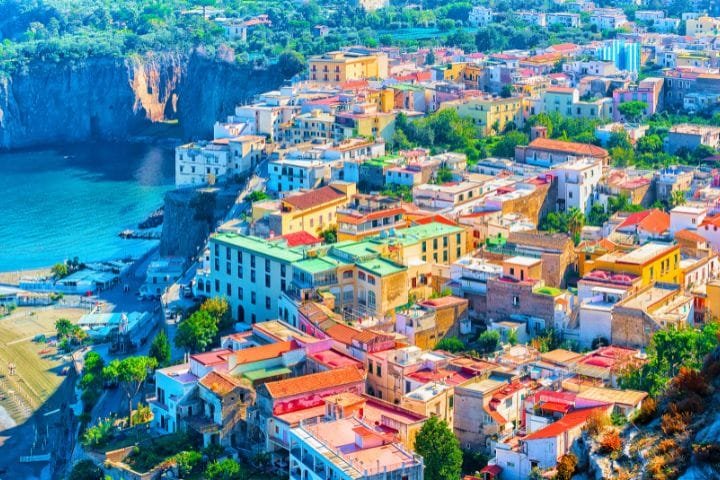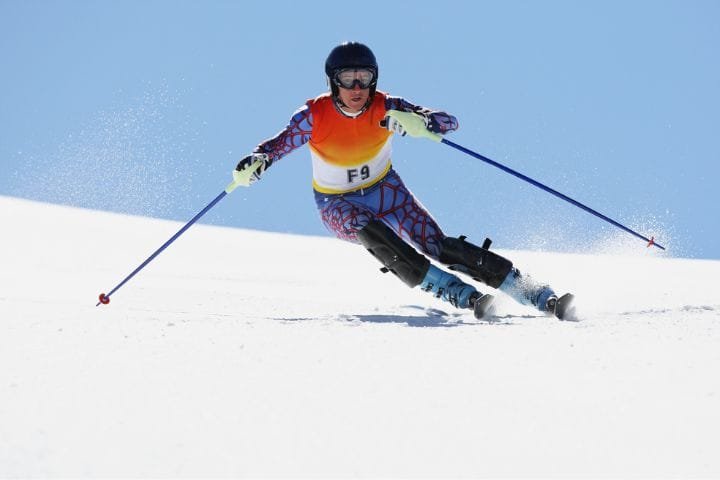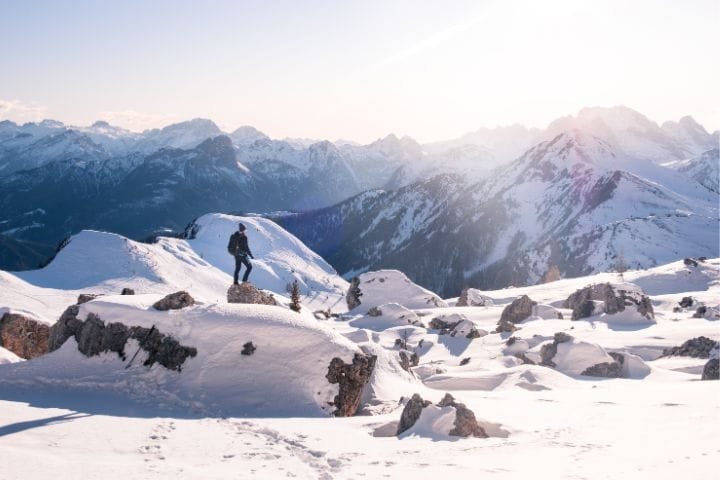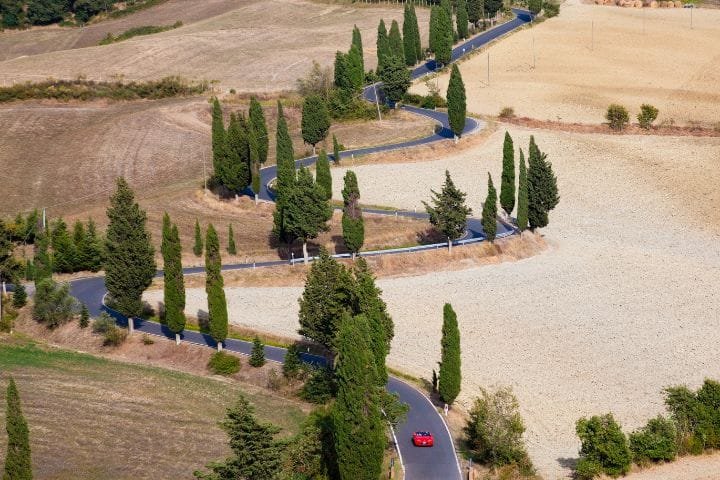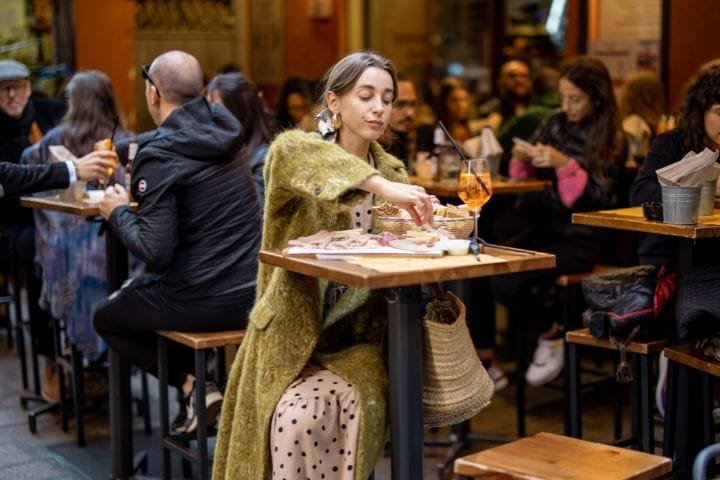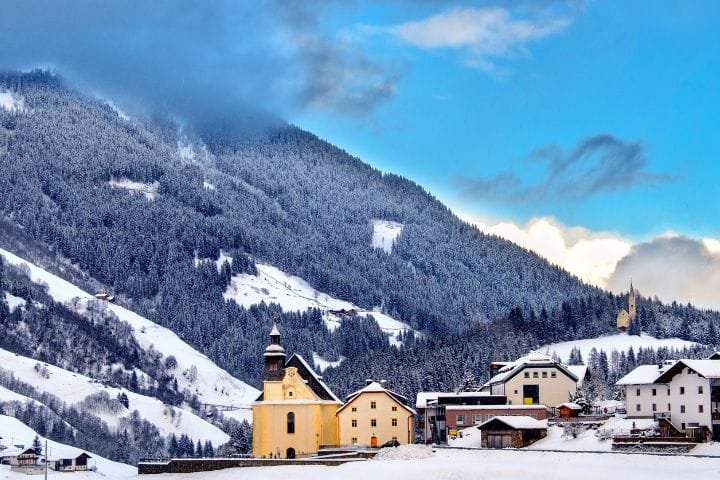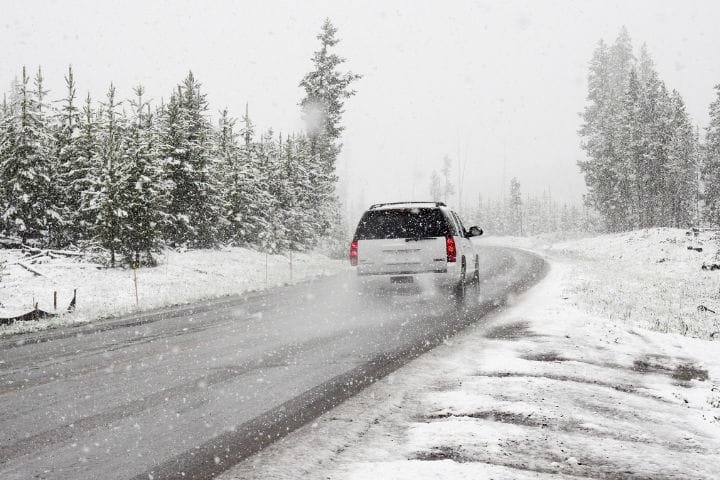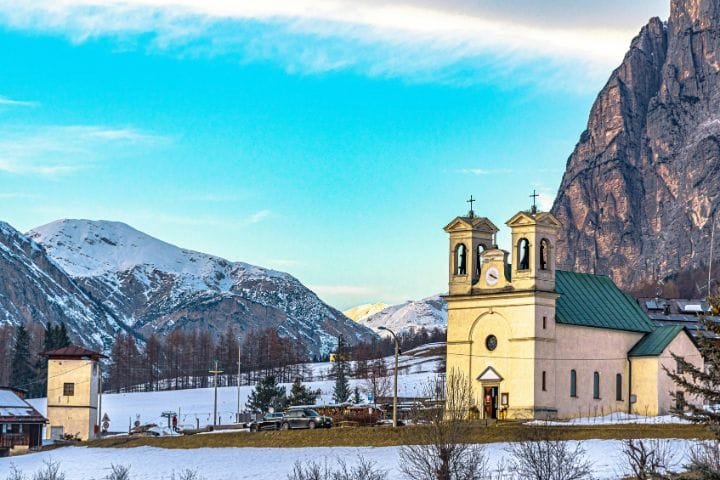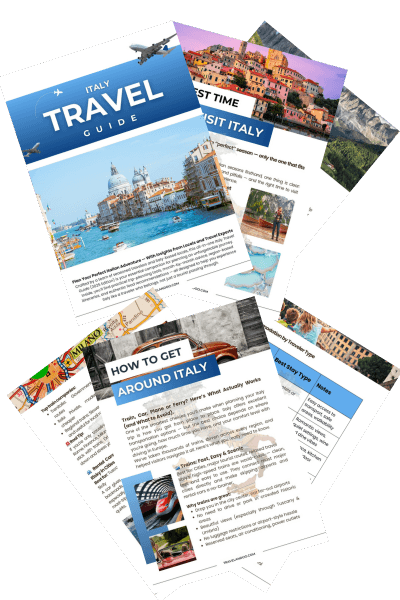Tuscany Scenic Drives: Discover Italy’s Most Beautiful Countryside Roads

by Abu | Last Updated December 19, 2025
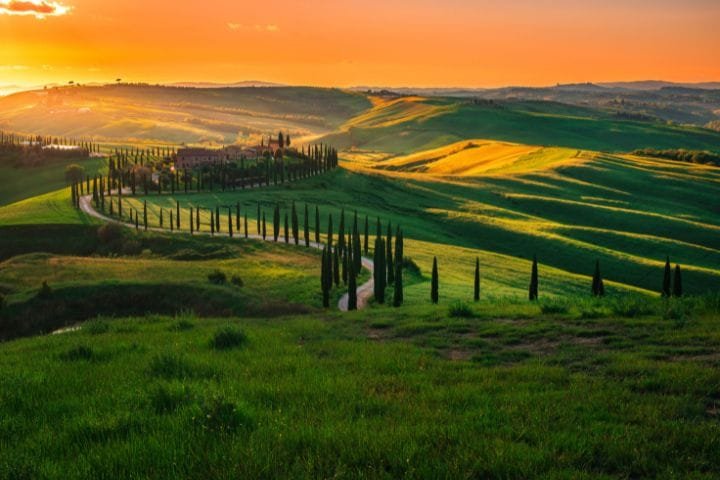
Ready to explore the countryside that has inspired artists, writers, and dreamers for centuries? After living in Italy for twenty years and exploring every corner of Tuscany’s incredible countryside, I can honestly say that these scenic drives never get old.
There’s something magical about the way morning mist rises from the Val d’Orcia valleys, how afternoon light transforms Chianti’s vineyards into liquid gold, and how every winding country road seems to lead to another postcard-perfect discovery.
I’ve driven these routes in every season, at every hour of the day, and with countless friends and family members experiencing Tuscany for the first time. The reaction is always the same – that moment when they realize they’re actually driving through landscapes that have inspired Renaissance masters, Hollywood films, and countless dreams of Italian countryside perfection.
Whether you’re seeking romantic sunset drives through golden wheat fields, wine-tasting adventures through legendary vineyard regions, cultural discoveries in UNESCO World Heritage landscapes, or simply the pure joy of navigating beautiful countryside roads where every turn reveals another postcard-perfect vista, Tuscany’s scenic drives offer experiences that define the very essence of Italian countryside beauty.
Let’s explore the most beautiful countryside roads that showcase why Tuscany remains the world’s most beloved destination for scenic driving adventures!
🧭 Where Tuscany Fits Among Italy’s Scenic Drives
Tuscany is the heart of Italy’s countryside driving, connecting culture, landscapes, and slower-paced routes.
- Anchor your countryside driving around one region → Best scenic drives in Italy
- Keep scenic days relaxed and flexible → How to plan a perfect Italy road trip
Val d’Orcia: UNESCO World Heritage Scenic Routes

SR2 Via Cassia through rolling hills and cypress groves remains one of my absolute favorite drives in all of Italy. This ancient Roman road winds through the heart of Val d’Orcia, passing those iconic cypress-lined curves that have become synonymous with Tuscan beauty. The section between San Quirico d’Orcia and Pienza is particularly spectacular, with every turn revealing new compositions of rolling hills, scattered farmhouses, and perfectly placed cypress trees.
What makes this route special is how it changes throughout the day and seasons. Early morning brings mystical fog that clings to the valleys, while late afternoon light transforms the golden wheat fields into something almost ethereal. I’ve photographed this same stretch hundreds of times, and it never fails to surprise me with new beauty.
Pienza to Montalcino wine country drive combines UNESCO landscapes with world-class wine experiences. This route takes you through the heart of Brunello territory, where the most expensive and celebrated wines are produced in Italy. The drive itself is stunning – gentle hills covered in precisely manicured vineyards, medieval stone farmhouses, and those endless views that make you understand why this area was declared a World Heritage site.
I always recommend timing this drive during harvest season (late September to early October) when the vineyards are bustling with activity and the autumn light is absolutely magical. The wineries along this route range from massive commercial operations to small family-owned producers who have been making wine for generations.
Photography hotspots and golden hour timing require local knowledge that only comes from years of experience. The most famous cypress grove (Cipressi di San Quirico) is best photographed in early morning when the light is soft and the tour buses haven’t arrived yet. The chapel of Madonna di Vitaleta offers classic Tuscan compositions, while the views from Pienza’s walls provide sweeping panoramas of the entire valley.
Essential Val d’Orcia driving highlights:
- San Quirico d’Orcia: Renaissance gardens and thermal baths
- Montalcino: Brunello wine tastings and medieval fortress
- Pienza: Renaissance “ideal city” and pecorino cheese
- Castiglione d’Orcia: thermal springs and castle ruins
- Bagno Vignoni: a unique thermal pool village square
🌄 Iconic Tuscan Drives to Pair Together
Val d’Orcia works beautifully when combined with nearby countryside routes.
- Rolling hills and wine villages from Rome → Driving from Rome to Siena through Tuscany
- Countryside-focused route toward Florence → Driving from Rome to Florence with must-see stops
- Food-and-landscape driven Tuscany journey → Epic Milan to Florence drive
Chianti Classico: Wine Country Scenic Roads

SR222 Chiantigiana wine route from Florence to Siena represents the classic Tuscan wine country experience. This historic road connects Italy’s Renaissance capital with its medieval heart, passing through some of the world’s most prestigious wine regions. I’ve driven this route countless times, and it never fails to deliver that perfect combination of natural beauty and cultural richness.
The road itself winds through gentle hills covered in vineyards, olive groves, and oak forests, with medieval villages and ancient castles perched on strategic hilltops. Each season brings different beauty – spring wildflowers, summer’s lush green landscapes, autumn’s harvest colors, and winter’s stark beauty that reveals the landscape’s underlying structure.
Castello di Brolio and historic wine estate drives provide access to some of Chianti’s most prestigious producers. The Ricasoli family has been making wine at Brolio since 1141, and their estate offers both incredible wines and spectacular views over the Chianti countryside. The drive to Brolio alone is worth the trip, winding through ancient forests and emerging onto hilltops with sweeping valley views.
Greve in Chianti to Castellina scenic loop represents my favorite shorter circuit for visitors with limited time. This route passes through the heart of Chianti Classico, offering opportunities to visit family wineries, explore medieval villages, and experience authentic Tuscan countryside culture. The loop takes about 2-3 hours with stops, perfect for a leisurely afternoon of wine tasting and cultural discovery.
Vineyard visits and tasting room stops provide insights into Chianti’s winemaking traditions and innovations. Many estates offer tours that explain the connection between terroir, tradition, and quality, while smaller family producers provide intimate experiences where you might share wine with the actual winemaker.
Chianti essential experiences:
- Greve in Chianti: triangular market square and wine shops
- Castellina: medieval walls and Etruscan archaeological sites
- Radda in Chianti: an ancient fortified village and wine cooperatives
- Volpaia: a perfectly preserved medieval wine village
- Castello di Verrazzano: historic estate and Renaissance gardens
🍷 Wine Country Scenic Routes Beyond Chianti
Chianti is just one part of Tuscany’s broader wine-country road network.
- Classic countryside loops and hilltop towns → Driving from Rome to Siena through Tuscany
- Central Italy scenic connector → Driving from Rome to Pisa through western Tuscany
- Quieter northern wine regions → Hidden scenic routes in Piedmont
Crete Senesi: Dramatic Clay Hill Landscapes

Asciano to Pienza moonscape scenery offers some of Tuscany’s most dramatic and otherworldly landscapes. The Crete Senesi region features rolling hills of white and gray clay that create an almost lunar landscape, particularly striking during early morning or late afternoon when long shadows emphasize the dramatic topography.
I often bring visitors here when they think they’ve seen all of Tuscany’s beauty. The Crete Senesi challenges preconceptions about what Tuscan countryside looks like, offering minimalist landscapes that feel more like abstract art than traditional pastoral scenes.
Biancane clay formations and lunar landscapes create unique photographic opportunities that feel completely different from typical Tuscan imagery. These white clay hills, formed by ancient marine sediments, create surreal landscapes that change dramatically with lighting conditions and seasonal weather patterns.
Abbey of Monte Oliveto Maggiore cultural stop provides spiritual and artistic enrichment in this unique landscape. This 14th-century monastery houses incredible frescoes and offers peaceful reflection in one of Tuscany’s most unique settings. The approach to the abbey through cypress-lined roads is particularly beautiful.
Sunrise and sunset photography opportunities in the Crete Senesi are legendary among landscape photographers. The minimal compositions and dramatic lighting conditions create images that capture the essence of this stunning landscape. I’ve spent countless mornings here watching the sun rise over these ancient clay hills.
Crete Senesi highlights:
- Asciano: medieval town and starting point for clay hill exploration
- Biancane formations: otherworldly white clay landscapes
- Abbey of Monte Oliveto Maggiore: frescoed monastery in a unique setting
- Rapolano Terme: thermal springs and wellness experiences
- San Giovanni d’Asso: truffle capital and autumn festivals
Maremma: Coastal Hills and Wild Tuscany

Grosseto to Pitigliano archaeological routes reveal Tuscany’s wilder, less-developed side. The Maremma region offers dramatic landscapes that feel more like the American Southwest than typical Tuscan countryside, with ancient Etruscan settlements perched on volcanic tufa cliffs and vast stretches of Mediterranean wilderness.
This area remained largely uninhabited for centuries due to malaria, which ironically preserved incredible archaeological sites and wild landscapes that offer completely different Tuscan experiences. The drive to Pitigliano is particularly spectacular, with the ancient city appearing suddenly from the surrounding countryside like something from a fantasy novel.
Etruscan hilltop towns and ancient settlements provide cultural experiences that predate Roman civilization. Towns like Pitigliano, Sovana, and Sorano offer insights into pre-Roman Italian culture while showcasing dramatic architecture carved directly into volcanic rock formations.
Coastal drives with Mediterranean views combine inland hill country with stunning coastal scenery. The Maremma’s coast offers pristine beaches, protected natural areas, and seaside villages that maintain authentic fishing culture away from mass tourism.
Natural hot springs and seaside villages provide relaxation opportunities in spectacular natural settings. The thermal springs at Saturnia create terraced pools of warm water surrounded by countryside, while coastal villages like Castiglione della Pescaia offer authentic seaside experiences.
Maremma scenic drive essentials:
- Pitigliano: “Little Jerusalem” carved into volcanic cliffs
- Sovana: Etruscan necropolis and medieval architecture
- Saturnia: natural thermal springs and ancient Roman baths
- Castiglione della Pescaia: an authentic fishing village and beaches
- Scansano: Morellino wine region and wild boar cuisine
Plan Your Trip with Our Favorite Booking Tools
Garfagnana: Mountain Valleys and Medieval Villages

Lucca to Castelnuovo di Garfagnana mountain route offers dramatic Alpine scenery that surprises visitors expecting only rolling hills from Tuscany. This northern region is characterized by the Apuan Alps, marble quarries, and traditional mountain villages that preserve authentic rural culture.
The drive through Garfagnana valleys provides constantly changing scenery as you wind through chestnut forests, past marble quarries, and along mountain streams. The contrast with southern Tuscany’s gentle hills is striking, offering a completely different perspective on regional diversity.
Apuan Alps backdrop and marble quarries create dramatic landscapes where Michelangelo sourced marble for his sculptures. The white scars on the mountainsides mark centuries of quarrying activity, while the mountains themselves provide spectacular backdrops for countryside drives.
Traditional villages and chestnut forests showcase authentic mountain culture that has remained largely unchanged for generations. These communities maintain traditional crafts, cuisine, and festivals that provide insights into rural Italian life.
Seasonal considerations and weather patterns become more important in mountain areas where winter snow and summer heat can affect driving conditions. Spring and fall offer ideal weather for exploring these elevated regions.
Garfagnana exploration highlights:
- Barga: a medieval village with spectacular mountain views
- Castelnuovo di Garfagnana: traditional market town and cultural center
- Marble quarries: dramatic industrial landscapes and sculptural stone
- Chestnut forests: seasonal beauty and traditional mountain cuisine
- Fortress of Verrucole: medieval castle with panoramic valley views
Mugello and Casentino: Northern Tuscany Hidden Gems

Florence to Borgo San Lorenzo countryside offers easy access to authentic Tuscan landscapes just 30 minutes from the Renaissance capital. The Mugello region features rolling hills, medieval villages, and Medici villas that provide cultural richness without the tourist crowds of more famous areas.
This area represents what Chianti was like before international tourism discovered it – authentic, affordable, and incredibly beautiful. The landscapes are classic Tuscan countryside, but the experiences feel more genuine and less commercialized.
Casentino forests and monastery visits provide spiritual and natural experiences in one of Tuscany’s most pristine wilderness areas. The Casentino National Park protects ancient forests and wildlife while offering access to historic monasteries that have operated for over a thousand years.
Renaissance villas and Medici estates showcase the region’s aristocratic heritage through beautifully preserved architecture and gardens. These properties offer insights into Renaissance lifestyle and artistic patronage that shaped Tuscan culture.
Seasonal festivals and local traditions in these less-touristed areas provide authentic cultural experiences. Local festivals celebrate everything from chestnuts to wine, offering opportunities to interact with traditional communities.
Northern Tuscany discoveries:
- Scarperia: medieval village and knife-making traditions
- Vicchio: birthplace of Giotto and Renaissance art connections
- Camaldoli: ancient monastery and hermitage in pristine forests
- Poppi: a perfectly preserved medieval castle and village
- Medici villas: Renaissance architecture and gardens
Eastern Tuscany: Arezzo and Cortona Routes

Arezzo to Cortona hilltop town connections showcase medieval architecture and Renaissance art in spectacular hilltop settings. This region offers incredible cultural richness combined with classic Tuscan landscapes, plus connections to Umbria that extend exploration possibilities.
The drive between these ancient cities winds through the Chiana Valley, one of Tuscany’s most fertile agricultural areas. The landscapes here inspired Renaissance artists and continue to provide classic Tuscan countryside beauty.
Chiana Valley agricultural landscapes represent traditional Tuscan farming culture with geometric field patterns, scattered farmhouses, and ancient drainage systems that transformed marshland into productive agriculture. The valley’s flat terrain contrasts beautifully with the surrounding hills.
“Under the Tuscan Sun” filming locations attract visitors interested in the romantic vision of Tuscan countryside life. Cortona and surrounding areas featured prominently in the film, showcasing authentic countryside beauty and village culture.
Antique markets and cultural attractions provide shopping and cultural experiences that reflect the region’s artistic heritage. Arezzo’s monthly antique fair is one of Italy’s most important, while Cortona offers intimate cultural experiences in a perfectly preserved medieval setting.
Eastern Tuscany cultural highlights:
- Arezzo: Piero della Francesca frescoes and monthly antique fair
- Cortona: Etruscan heritage and Renaissance art museums
- Castiglion Fiorentino: medieval fortress and valley views
- Lucignano: a circular medieval village and an authentic atmosphere
- Foiano della Chiana: Renaissance architecture and local traditions

Practical Tips for Tuscany Scenic Driving
Best seasons and weather considerations dramatically affect countryside driving experiences. Spring (April-May) offers wildflowers and comfortable temperatures, while fall (September-October) provides harvest season activities and spectacular autumn colors. Summer can be hot and crowded, while winter provides intimate experiences but limited daylight hours.
Navigation and GPS reliability in the countryside requires backup planning because satellite reception can be spotty in hill country. Download offline maps and carry traditional paper maps for rural areas where GPS might fail. Many of the most beautiful roads aren’t well-marked in navigation systems.
Fuel stations and service availability become strategic considerations in rural areas where services may be limited. Fill up in larger towns before heading into the countryside, and note that many rural stations close during lunch hours and Sundays.
Photography equipment and timing can make or break countryside photography experiences. Golden hour lighting (the first hour after sunrise and the last hour before sunset) transforms ordinary landscapes into magical compositions. Pack polarizing filters for enhanced sky contrast and tripods for low-light conditions.
Rural accommodation strategies:
- Book agriturismo stays for authentic countryside experiences
- Confirm precise directions and GPS coordinates before departure
- Understand meal times and availability in rural properties
- Pack appropriately for countryside activities and weather
- Respect local customs and agricultural activities

Plan Your Trip with Our Favorite Booking Tools
Embracing Tuscany’s Timeless Countryside Beauty
After twenty years of exploring these incredible roads, I can tell you that Tuscany’s scenic drives offer something far more valuable than just beautiful views – they provide connection to a landscape and culture that has remained unchanged for centuries.
These countryside roads tell stories of medieval trade routes, Renaissance artistic inspiration, and agricultural traditions that continue today.
The key to truly appreciating Tuscany’s scenic drives is understanding that they’re not just about getting from point A to point B – they’re about experiencing the rhythm of rural Italian life, discovering hidden villages and family wineries, and understanding how this landscape has shaped art, literature, and culture for over a thousand years.
My favorite experiences always happen when I abandon rigid itineraries and follow intriguing signs down unmarked country roads. Some of my most treasured Tuscan memories come from spontaneous discoveries: a medieval village festival where I was invited to join the celebration, or a sunrise viewpoint that revealed perspectives I’d never seen despite years of exploration.
Take your time, embrace the unexpected detours, and remember that in Tuscany, getting lost often leads to the most beautiful discoveries. The countryside will reward your patience with experiences that will forever change how you think about landscape, culture, and the art of slow travel.
Buon viaggio through the most beautiful countryside roads in the world!
Essential FAQs: Tuscany Scenic Drives
Is it easy to drive in Tuscany for tourists?
Yes! Tuscany’s countryside roads are generally well-maintained and enjoyable to drive. However, be prepared for narrow village streets, ZTL zones, and curvy rural roads.
Do I need a car to explore Tuscany’s scenic routes?
While trains connect major cities, having a car is the best way to explore Tuscany’s rolling hills, small towns, vineyards, and hidden viewpoints.
Are there guided scenic drives, or should I drive myself?
Both options are available. Self-driving gives you flexibility, while guided tours offer local insight and can be stress-free if you prefer not to navigate yourself.
What are the most beautiful scenic drives in Tuscany?
Val d’Orcia’s SR2 Via Cassia offers iconic cypress-lined roads and UNESCO landscapes. Chianti’s SR222 Chiantigiana connects Florence to Siena through world-famous wine country.
Crete Senesi provides dramatic clay hill moonscapes near Siena. Maremma features wild coastal drives and Etruscan hilltop towns. Each region offers distinct beauty, from rolling vineyard hills to dramatic volcanic landscapes and medieval villages perched on ancient cliffs.
When is the best time for Tuscany countryside driving?
Spring (April-May) brings wildflowers and comfortable temperatures. Fall (September-October) offers harvest season activities, autumn colors, and grape harvest experiences.
How long do these scenic drives take?
Val d’Orcia circuit: 2-3 hours with stops. Chianti wine route (Florence to Siena): 3-4 hours including tastings. Crete Senesi exploration: 2-3 hours for main highlights.
Individual routes between towns typically take 30-60 minutes of driving time, but plan full days when including stops for photography, wine tastings, village exploration, and spontaneous discoveries along unmarked country roads.
What should I know about driving in Tuscany countryside?
Download offline maps, as GPS reception can be spotty in hill country. Many beautiful roads aren’t well-marked in navigation systems. Fuel up in larger towns before heading into the countryside – rural stations close during lunch hours and Sundays.
Pack cash for small family wineries and rural restaurants. Respect agricultural activities and local customs. Spring and fall offer ideal weather conditions.
Are there accommodation options along these scenic routes?
Agriturismo farmhouse stays provide authentic countryside experiences with home-cooked meals and wine tastings—book directly with properties for the best rates and local insights. Confirm precise directions and GPS coordinates before departure.
Many rural properties offer cooking classes, wine tours, and cultural activities. Medieval villages often have small boutique hotels in converted palaces. Reserve well in advance for harvest season (September-October).
🏁 Build a Tuscany-First Scenic Italy Route
Tuscany works best as the countryside core of a larger Italy road trip.
- Combine countryside, coast, and mountains → Best scenic drives in Italy
- Keep routes enjoyable and well-paced → How to plan an Italy road trip
💬 We’d love to hear from you!
Have questions, tips, or personal travel stories to share? Drop them in the comments below — your insights help fellow travelers plan their adventures too.

